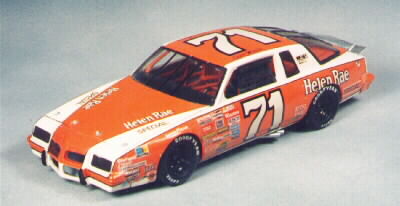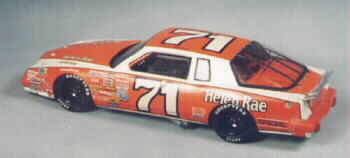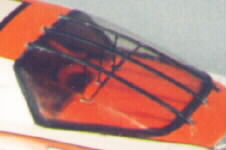
This 62-year-old, 5' 1" tall lady loved NASCAR, and was in a strong position to indulge herself. And she did, for a short while. One of her sons-in-law was Gene Barkdoll, brother of fringe racer Phil Barkdoll, whose specialite was makin' the 500 at Daytona, and spectacular accidents. It was watching videos of Phil's racing that got her into it in a big way, around 1984-85.
They tried to run a WC team out of Iowa, and went thru a lot of cash, and several drivers, from Morgan Shepherd and Sterling Marlin, both of whom were just getting started, to Ramo Stott, a veteran of the late '60's. For 1986, she decided to do it right, relocating the shops to North Carolina, and bringing the very experienced Dave Marcis in as part of a two-car team with Phil Barkdoll.
It was a pleasant time for Marcis; quoted here from SCR (Feb 87): "If we need ten tires, I can go buy them It's been a long time since I've been able to do that."
The Pontiac model you see here represents the car as raced in the 1986 Daytona 500, where it finished a dismal 38th with engine failure. As near as I can tell, the Pontiac ran for about the first half of the season, when they switched to a Monte Carlo. By 1987, Dave had Lifebuoy sponsorship, and the Helen Rae Specials were no more...
We know where Dave is today - some things never change. Helen Rae? Well, she'd be 75 or so today, not that old by modern standards. I don't know... Wonder if she still enjoys WINSTON CUP?
As unusual as Helen was in NASCAR, the Grand Prix 2+2 was an oddity itself. Pontiac's response to the aerodynamic T-Birds and the Monte Carlo Aerocoupe coming into competition, this beast was built offline for Pontiac in Detroit. Just enough were made to meet the NASCAR "homologation rule" of, I believe, 500 units.
As a street vehicle, they were less than practical, with a tiny little trunklid that could barely fit a spacesaver spare, or a full bag of groceries. And Lord help you if it ever slid to the front of the trunk!
I've only ever seen one, on the street here in Oshawa - looked mighty fine, it did - and years ago, I heard rumours that most of the run was rusting away in one of GM's terminal lots in the Detroit area... I do know that in '93 Richard Petty had one stored at his complex, buried under debris, gathering dust... I saw it...
It was in one of these beasts, by the way, that Rusty Wallace got his first win, at Bristol, in '86.
 The model pictured was built by grafting a JNJ resin transkit onto a Petty early '80's notchback Grand Prix. Not for the faint of heart! That's why there's only one 2+2 in my collection!
The model pictured was built by grafting a JNJ resin transkit onto a Petty early '80's notchback Grand Prix. Not for the faint of heart! That's why there's only one 2+2 in my collection!
Nothing against the transkit - it works well, and can be made to fit. A former member of the model club I belong to, Group 25, built one ten years or so back, in the Petty colour scheme of the time - real pretty car. He even hinged that tiny little rear decklid! Out of my league...
There is also a resin body available from All-American, it's not too bad, I just haven't had a go at it yet...
The decals for this car came from JNJ, and paint was from Canadian Tire (touch-up aerosol) matched to a photo in that Feb 87 issue of SCR. The black pinstriping on the white/orange breaks was not on the decal sheet, but came from an aicraft decal of some kind... The usual oil lines, plug wires, etc were added, and the rear package shelf had to be fabricated, as did the rear spoiler.
 One unique item I felt had to be added was the interior rear bracing that helped hold that massive rear window in place. I don't think any other stocker has had so much glass area back there! This was done by temporarily fastening the window in place, then drilling through the molded-in exterior braces, and down thru the package shelf to ensure verticality, and good alignment. A tiny little baseplate for each brace was fastened to the shelf over the holes, and drilled out from underneath (holes already there, remember?) Prepainted thin plastic rod was then inserted thru the glass and into the package shelf, just prior to bare-metalling the exterior braces. Jeez... As the photo to the right shows, it worked out pretty well...
One unique item I felt had to be added was the interior rear bracing that helped hold that massive rear window in place. I don't think any other stocker has had so much glass area back there! This was done by temporarily fastening the window in place, then drilling through the molded-in exterior braces, and down thru the package shelf to ensure verticality, and good alignment. A tiny little baseplate for each brace was fastened to the shelf over the holes, and drilled out from underneath (holes already there, remember?) Prepainted thin plastic rod was then inserted thru the glass and into the package shelf, just prior to bare-metalling the exterior braces. Jeez... As the photo to the right shows, it worked out pretty well...
For 1988, the new downsized W-car version of the Grand Prix was out, and we began that odd journey to where we are today - all the cars represented in NASCAR WC racing, while front-drivers on the street, still have that 1965-Galaxie-derived rear-drive race chassis underneath 'em...
| To Home Page | To Models Index Page | To Top of Page |